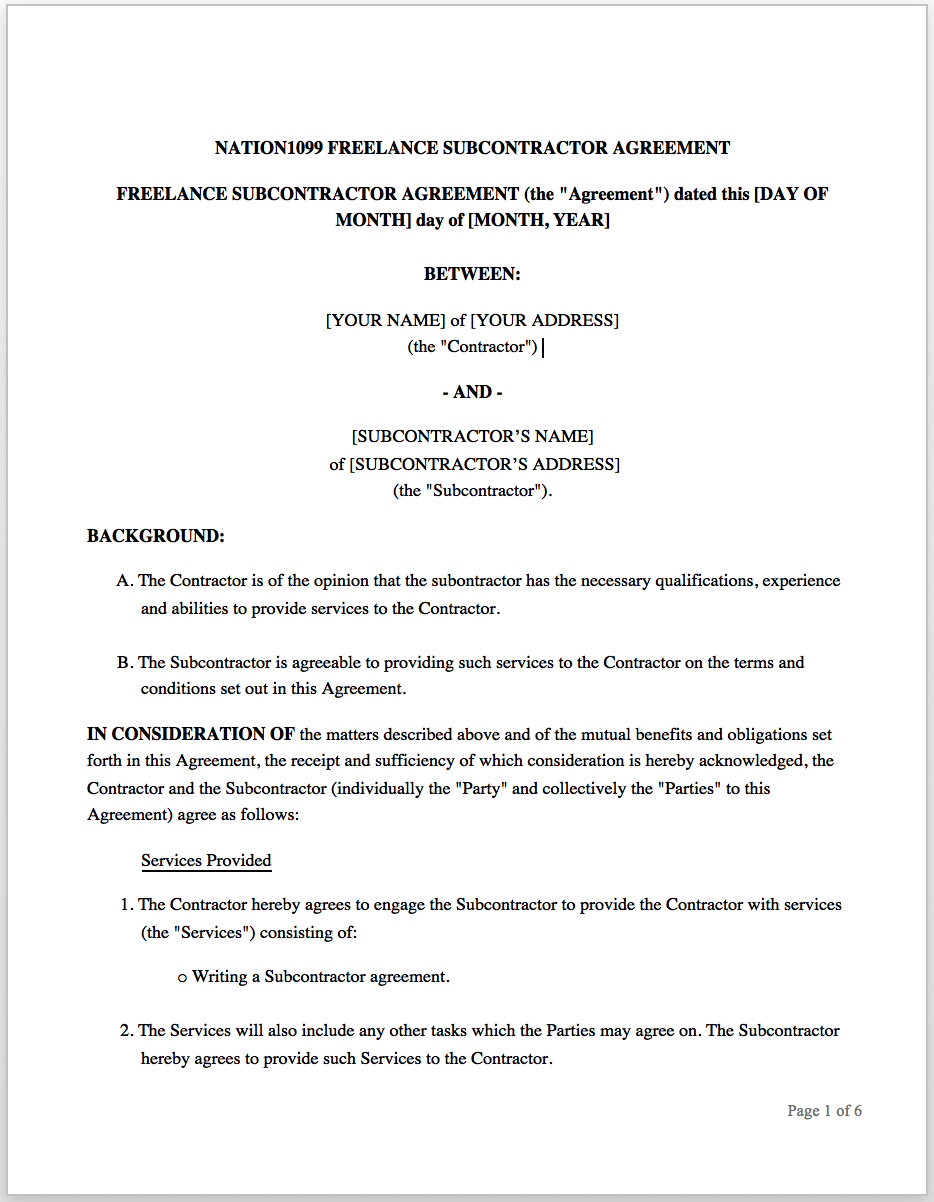Feeling a little swamped? Outsourcing pieces of your workload to other trusted freelancers and colleagues means more clients, more billable hours and less grunt work (if you’re doing it right). If you’re looking to take the next step in growing your consulting business, sourcing and on-boarding additional help may be the critical next step for you. But how do you know when it makes sense to hire subcontractors and how do you actually go about finding them? We’ll cover it all below!
Are you passing along A LOT of referrals?
Your clients love your work and they love you — in fact they trust your opinion so much that they want your recommendation on virtually every role they need filled. You have plenty of friends online who need the work, so you connect them, give yourself a pat on the back and it’s a done deal, right?
It doesn’t have to be.
There’s nothing wrong with paying it forward to clients and peers by referring them to one another. But if you find yourself regularly referring talent and building teams for your clients, you should get something for your efforts and for the value of your network. If you coordinate the communication between two parties and tack on a fee with each invoice, you will get so much more out of your connections than just good vibes.
Getting more work than you can handle?
Here we have a “duh” example. Almost anyone can tell when they’re drowning in work but most consultants have a very difficult time spinning this challenge into an opportunity. Nation1099 contributor Kathleen Krueger recalls the “good problem” she had early in her writing career in a recent blog and her reluctance to pass up any quality work with the unpredictability of the solo lifestyle.
“I had several regular and repeat clients and at times way more work than I could handle on my own,” Krueger says. “Because I understood that freelance work can have its peaks and valleys, I didn’t want to turn away any of my clients.”
This where she made a very smart move. She contacted a highly experienced writer in her circle and put him to work cranking out the blogs and written content for her hungry clients. She kept pace with her increasing work load, got a friend in need some additional work and made more money on top of it — money she earned by adding value to her client.

Would you like a copy of the subcontractor agreement template that a lot of people in the Nation1099 community use? We can send you one!
Do you need to generate more income without overloading your hours?
The answer here is probably “yes” regardless, but this is a strategic benefit that bears mention when exploring the world of subcontracting. Finding lower-effort ways to maximize income is how freelancing becomes solopreneurship. Subcontracting is a pivotal step in delivering more value and building long-term sustainability for your business. Naturally, it does require some work to find and hire subcontractors — especially good ones (more on that below) — but the benefits often outweigh the costs. You have more clients paying you more to effectively do less.
To guarantee this added benefit, Web Design for Dummies author Lisa Lopuck advises in a recent post that those looking to take this leap must be mindful of their subcontractors’ rates before delivering a proposal. “Plan for your subcontractors by getting a fixed-bid estimate from them that you can then roll into your overall project budget,” she says.
Always try to avoid surprising your clients with fees they didn’t anticipate.
More on this topic: Advice for My Younger Self: Independent Contractors Share What They Wish They Knew Starting Out
Do you want to offer new services to clients without hiring full-time staff?
Your client loves your web design but could really use an overhaul in the graphics department. Unfortunately, you aren’t very fluid in this field and aren’t sure whether it’s a completely worthwhile service to offer.
But you happen to have a colleague from your last job who specializes in graphic design and bring her on board temporarily to gauge your client’s response. It’s a smashing success — your client loves the design, you have more money in your pocket and now know you can offer a wider scope of services to your clients.
A theme we come back to often at Nation1099 is the necessity of deriving more value from your existing clients. When you hire subcontractors, you unlock the door to many more avenues of income. Creatively look at your clients and peers and see where you can find connections — they can make your life a lot easier.
Are you willing to make the managerial investment?
As mentioned earlier, there are costs associated with subcontracting — time and a managerial burden being among the main concerns. While assigning tasks to other freelancers can lessen our work loads, we do earn our additional income with the tax and contract legwork that is necessary for this type of business relationship.
In the same way we need to keep our finances organized for our own tax liabilities, we have to do the same for the people working under us. We also have to accurately define the scope of work with them and keep these terms well documented.
Some consultants are very happy to avoid managing others and there’s nothing wrong with that, but writing off managed collaboration with subcontractors could be closing you out of a chance to grow your income and your business. You may find it quite literally pays to keep an open mind!
How to find subcontractors
So let’s say business is booming and your operation really could use some extra creatives on the job — how do you actually find subcontractors, and make sure they’re just right for the job? — They don’t grow on trees, do they?
We’ll explore the essential tips you need in order to find and evaluate them below.
Tap your network and follow through with the credentials
Occam’s Razor is the philosophical idea that when attempting to explain an occurrence, the simplest answer is most likely the correct one. You can apply a similar principle to your search for subcontractors — your best options will often be the closest qualified connections in your network.
Past coworkers, roommates and online friends are all fertile resources for subcontracting and obtaining referrals to other talent within their respective networks. Obviously, there is a degree of built-in trust that comes with these recommendations, which can streamline your on-boarding process. However, you will still need to closely examine past experiences for fit purposes and may even want to reach out to some of their past employers.
You also won’t always find the subcontractors you need right in your backyard and, if this is the case, it’s much better to do a little more digging than to settle for a developer who is unfamiliar with your back end or a writer who knows nothing about your business.
Plan ahead and don’t be so hasty to close the deal — try it first
When is the best time to hire subcontractors? Right when you need them, right? If you want to be swamped and frantic, sure. There is a natural way working relationships develop, especially with less-familiar connections. You need to develop confidence your associate can deliver, and that he or she will deliver in a timely manner as well.
To this end, Shane Pearlman, founder of the 100% freelance agency Modern Tribe, recommends devoting about $200 to a small task you can have your associate in question “try out” with.
“If that is a nice experience, we offer a slightly larger gig (if we have something available),” says Pearlman in his Mashable blog. “Kick butt again, and we’ll line up a solid project. It’s kind of like dating.”
Anyone — even close contacts — may need some guidance in acclimating to the way you work. Consider planning ahead and trying out new team members with a little coding or a blog for your site during a time that you are not inundated. Your instruction will be better for the subcontractor and the stakes will be lower.
Create an interview process that speaks to needs and character
It can be easy to forget that there is more to the interview process than ability alone — you have to like working with these people. You may not see them all of the time but if it’s a chore to communicate with these individuals or you don’t collaborate well together, you can be in for some major headaches.
Brian Casel, founder of content marketing firm Audience Ops, realized this after a less than optimal first attempt at hiring subcontractors. “During those initial calls with the potential sub-contractor, I wanted to know whether or not this person can meet the requirements for this project,” says Casel. “Instead, I should have been focusing more on getting to know them.”
This is huge. No independents want to feel like numbers — it’s important to create a relationship with them that goes a little deeper than small talk. Casel assembled a great list of interview questions that speak to both skill and people concerns. One question to make special note of is “what types of projects are you most interested in working on?” Don’t leave this one out!
Formalize your relationship with a written contract
Speaking of saving yourself headaches — if you’ve done the cute, little test project with your subcontractor and are ready to bring them on for consistent work, you need to issue a contractual agreement to this individual.
This is crucial for tax documentation (you do not want the IRS thinking your subcontractors are employees!) and it also protects you and your collaborators from messy variables that can fall from the sky (underestimated hours, work uncompleted, unsatisfactory results, etc).
We’ll talk in greater depth about the nuances of a good subcontracting document in an upcoming feature but the gist is making sure that you have your desired terms (expectations, scope of work, deadlines, process specifics) in writing — or digital signature (Adobe Sign is a good way to go) before you push go.
Be transparent with all parties
While we tend to think of subcontracting primarily as a relationship between the contractor and his additional freelance team, the client’s role in all of this is not to be overlooked.
Many solos like to pretend that their contingent staff are their employees — this front may work for a little while but clients can often see through this veil. The fact is, there really isn’t a good reason to hide your subcontracting collaborators. Most clients understand that this practice is industry standard and are generally comfortable with the arrangement if you are ultimately held accountable for the quality of the work.
As you hire subcontractors and bring new faces into your ranks, take care to inform your clients. Everyone will breathe easier.

Ben Shanbrom is a freelance writer, musician and copy editor who works with artists and other clients around his native New Haven and well beyond.











